The NVIDIA GeForce RTX 2080 Ti & RTX 2080 Founders Edition Review: Foundations For A Ray Traced Future
by Nate Oh on September 19, 2018 5:15 PM EST- Posted in
- GPUs
- Raytrace
- GeForce
- NVIDIA
- DirectX Raytracing
- Turing
- GeForce RTX
Wolfenstein II: The New Colossus (Vulkan)
id Software is popularly known for a few games involving shooting stuff until it dies, just with different 'stuff' for each one: Nazis, demons, or other players while scorning the laws of physics. Wolfenstein II is the latest of the first, the sequel of a modern reboot series developed by MachineGames and built on id Tech 6. While the tone is significantly less pulpy nowadays, the game is still a frenetic FPS at heart, succeeding DOOM as a modern Vulkan flagship title and arriving as a pure Vullkan implementation rather than the originally OpenGL DOOM.
Featuring a Nazi-occupied America of 1961, Wolfenstein II is lushly designed yet not oppressively intensive on the hardware, something that goes well with its pace of action that emerge suddenly from a level design flush with alternate historical details.
The highest quality preset, "Mein leben!", was used. Wolfenstein II also features Vega-centric GPU Culling and Rapid Packed Math, as well as Radeon-centric Deferred Rendering; in accordance with the preset, neither GPU Culling nor Deferred Rendering was enabled.
| Wolfenstein II | 1920x1080 | 2560x1440 | 3840x2160 |
| Average FPS |  |
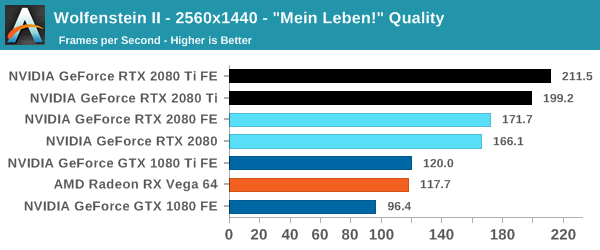 |
 |
| 99th Percentile | 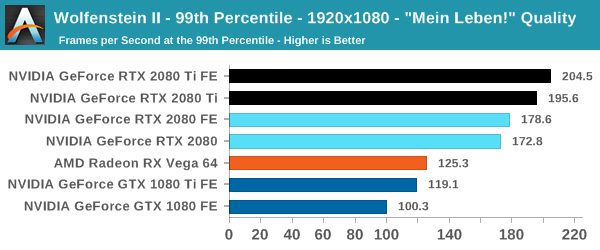 |
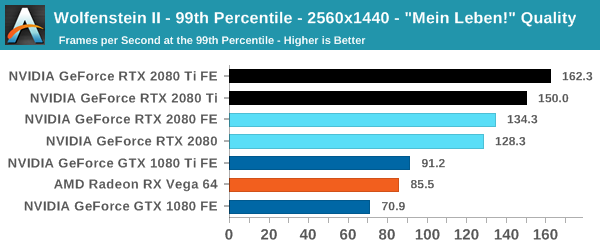 |
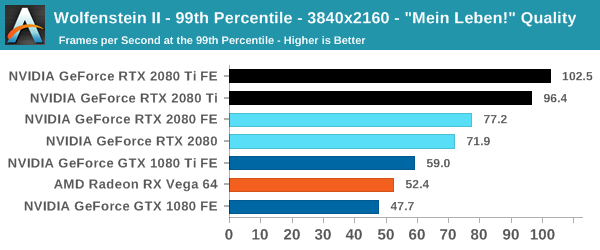 |
I am actually impressed with Wolfenstein II and its Vulkan implementation more than the absurd 250+ framerates, if only because many other games hold back the GPU because of the occurring CPU bottleneck. In DOOM, there was a hard 200fps cap because of engine/implementation limitations, a bit of a corner case, but manufacturers make 240Hz monitors nowadays, too. On a GPU performance profiling side, of course, reducing the CPU bottleneck makes comparing powerful GPUs much easier at 1080p, and with a better signal-to-noise than at 4K.
This is combined with the fact that at 4K, the 20 series are looking a huge 60 to 68% lead over the 10 series, and we'll be cross-referencing these performance deltas with other sections of the game. Even in the case of a 'flat-track bully' scenario where the 2080 Ti is running up the score, the 2080 Ti's speed compared to the 2080 is somewhat less than expected at 24 to 27%. It's a somewhat intriguing result for an optimized Vulkan game, as the game runs and scales generally well across the board; It's also not unnoticed that both the RX Vega cards and GeForce Turing cards outperform their expected positions, though without the graphics workload details it's hard to speculate with substance. With framerates like these, the 4K HDR dream at 144 Hz is a real possibility, and it would be interesting to compare with Titan V and Titan Xp results.


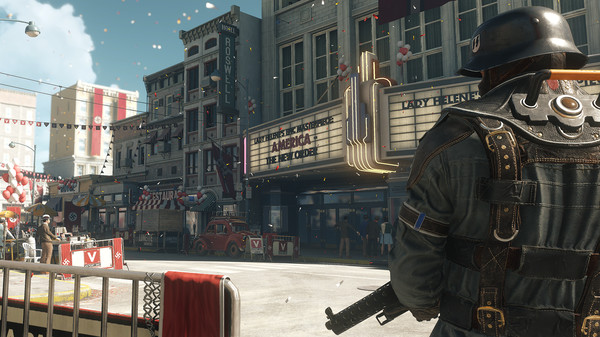









337 Comments
View All Comments
AnnoyedGrunt - Friday, September 21, 2018 - link
I think it was actually much less, judging by comments made in one of the reviews I linked. Maybe around $350 or so, which was very expensive at the time. It is true that it was a revolutionary card, but at the same time it was greeted with a lukewarm reception from the gaming community. Much like the 20XX series. I doubt that the 20XX will seem as revolutionary in hindsight as the GeForce256 did, but the initial reception does seem similar between the two. Will be interesting to see what the next year brings to the table.-AG
eddman - Friday, September 21, 2018 - link
Wow, that's just $525 now. I'm interested in old card prices because some people claim they have always been super expensive. It seems they have a selective memory. I'm yet to find a card more expensive than 2080 Ti from that time period.I'm not surprised that people still didn't buy many 256 cards. The previous cards were cheaper and performed close enough for the time.
abufrejoval - Thursday, September 20, 2018 - link
I am pretty sure I'll get a 2080ti, simply because nothing else will run INT4 or INT8 based inference with similar performance and ease of availability and tools support. Sure, when you are BAIDU or Facebook, you can buy even faster inference hardware or if you are Google you can build your own. But if you are not, I don't know where you'll get something that comes close.As far as gaming is concerned, my 1080ti falls short on 4k with ARK, which is noticeable at 43". If the 2080ti can get me through the critical minimum of 30FPS, it will have been worth it.
As far as ray tracing is concerned, I am less concerned about its support in games: Photo realism isn't an absolute necessity for game immersion.
But I'd love to see hybrid render support in software like Blender: The ability to pimp up the quality for video content creation and replace CPU based rander farms with something that is visually "awsome enough" points towards the real "game changing" capacity of this generation.
It pushes three distinct envelopes, raster, compute and render: If you only care about one, the value may not be there. In my case, I like the ability to explore all three, while getting an 2080ti for me allows me to push down an 1070 to one of my kids still running an R290X: Christmas for both of us!
mapesdhs - Thursday, September 27, 2018 - link
In the end though that's kinda the point, these are not gaming cards anymore and haven't been for some time. These are side spins from compute, where the real money & growth lie. We don't *need* raytracing for gaming, that glosses over so many other far more relevant issues about what makes for a good game.Pyrostemplar - Thursday, September 20, 2018 - link
High performance and (more than) matching price. nVidia seemingly put the card classification down one notch (x80 => x70; Ti => x80; Titan => Ti) while keeping the prices and overclocked then from day one so it looks like solid progress if one disregards the price.I think it will be a short lived (1 year or so) generation. A pricey stop gap with a few useless new features (because when devs catch up and actually deploy DXR enabled games, these cards will have been replaced by something faster).
ballsystemlord - Thursday, September 20, 2018 - link
Spelling/grammar errors (Only 2!):Wrong word:
"All-in-all, NVIDIA is keeping the Founders Edition premium, now increased to $100 to $200 over the baseline"
Should be:
"All-in-all, NVIDIA is keeping the Founders Edition premium, now increased from $100 to $200 over the baseline"
Missing "s":
"Of course, NVIDIA maintain that the cards will provide expected top-tier"
Should be:
"Of course, NVIDIA maintains that the cards will provide expected top-tier"
Ryan Smith - Thursday, September 20, 2018 - link
Thanks!ballsystemlord - Thursday, September 20, 2018 - link
Nate! Can you add DP folding @ home benchmark numbers? There were none in the Vega review and only SP in this Nvidia review.SanX - Thursday, September 20, 2018 - link
Author thinks that all gamers buy only fastest cards? May be. But I doubt all of them buy the new generestion card every year. In short, where are comparisons to 980/980Ti and even 780/780Ti? Owners of those cards are more interested to upgrade.milkod2001 - Friday, September 21, 2018 - link
See from top menu on right, there is a bench where you can see results. I presume they add data to huge database soon. And yes,people are talking about high end GPU but most are spending $400 max. for it.